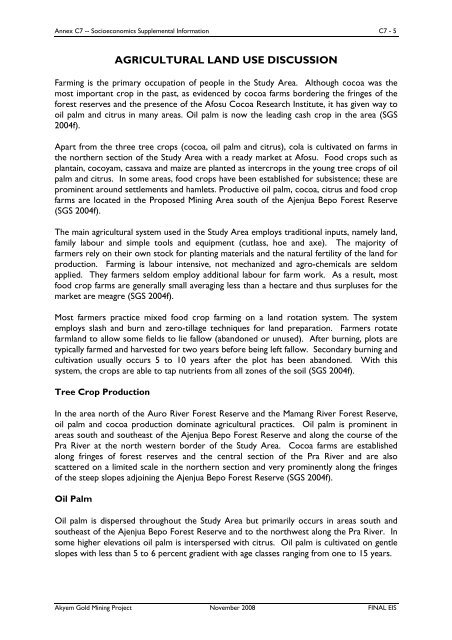annexc - Newmont Mining Corporation
annexc - Newmont Mining Corporation
annexc - Newmont Mining Corporation
You also want an ePaper? Increase the reach of your titles
YUMPU automatically turns print PDFs into web optimized ePapers that Google loves.
Annex C7 -- Socioeconomics Supplemental Information C7 - 5<br />
AGRICULTURAL LAND USE DISCUSSION<br />
Farming is the primary occupation of people in the Study Area. Although cocoa was the<br />
most important crop in the past, as evidenced by cocoa farms bordering the fringes of the<br />
forest reserves and the presence of the Afosu Cocoa Research Institute, it has given way to<br />
oil palm and citrus in many areas. Oil palm is now the leading cash crop in the area (SGS<br />
2004f).<br />
Apart from the three tree crops (cocoa, oil palm and citrus), cola is cultivated on farms in<br />
the northern section of the Study Area with a ready market at Afosu. Food crops such as<br />
plantain, cocoyam, cassava and maize are planted as intercrops in the young tree crops of oil<br />
palm and citrus. In some areas, food crops have been established for subsistence; these are<br />
prominent around settlements and hamlets. Productive oil palm, cocoa, citrus and food crop<br />
farms are located in the Proposed <strong>Mining</strong> Area south of the Ajenjua Bepo Forest Reserve<br />
(SGS 2004f).<br />
The main agricultural system used in the Study Area employs traditional inputs, namely land,<br />
family labour and simple tools and equipment (cutlass, hoe and axe). The majority of<br />
farmers rely on their own stock for planting materials and the natural fertility of the land for<br />
production. Farming is labour intensive, not mechanized and agro-chemicals are seldom<br />
applied. They farmers seldom employ additional labour for farm work. As a result, most<br />
food crop farms are generally small averaging less than a hectare and thus surpluses for the<br />
market are meagre (SGS 2004f).<br />
Most farmers practice mixed food crop farming on a land rotation system. The system<br />
employs slash and burn and zero-tillage techniques for land preparation. Farmers rotate<br />
farmland to allow some fields to lie fallow (abandoned or unused). After burning, plots are<br />
typically farmed and harvested for two years before being left fallow. Secondary burning and<br />
cultivation usually occurs 5 to 10 years after the plot has been abandoned. With this<br />
system, the crops are able to tap nutrients from all zones of the soil (SGS 2004f).<br />
Tree Crop Production<br />
In the area north of the Auro River Forest Reserve and the Mamang River Forest Reserve,<br />
oil palm and cocoa production dominate agricultural practices. Oil palm is prominent in<br />
areas south and southeast of the Ajenjua Bepo Forest Reserve and along the course of the<br />
Pra River at the north western border of the Study Area. Cocoa farms are established<br />
along fringes of forest reserves and the central section of the Pra River and are also<br />
scattered on a limited scale in the northern section and very prominently along the fringes<br />
of the steep slopes adjoining the Ajenjua Bepo Forest Reserve (SGS 2004f).<br />
Oil Palm<br />
Oil palm is dispersed throughout the Study Area but primarily occurs in areas south and<br />
southeast of the Ajenjua Bepo Forest Reserve and to the northwest along the Pra River. In<br />
some higher elevations oil palm is interspersed with citrus. Oil palm is cultivated on gentle<br />
slopes with less than 5 to 6 percent gradient with age classes ranging from one to 15 years.<br />
Akyem Gold <strong>Mining</strong> Project November 2008 FINAL EIS











